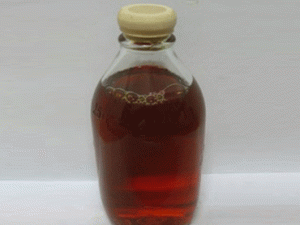
Oil displacement agent for heavy oil viscosity reduction

Specifications
| This product can form O/W emulsion with thick oil and has good fluidity at room temperature. The product has ultra-low oil-water interfacial tension and can evenly disperse thick oil in water; it has a good stabilising effect on gum and asphaltene, which will not precipitate out during use; it modifies the surface of thick oil hydrophilically and greatly reduces the power consumption of thick oil in the process of extraction and transportation. |
| Item | Index | ||||
| Appearance | freely movable liquid (20℃), non irritating odor | ||||
| pH value | 7.0- -9.0 | ||||
| Dissolution time, min | ≤10 | ||||
| Solid content, % | ≥45 | ||||
| Organochlorine content, % | 0.0 | ||||
| Viscosity reduction rate,% | ≥95% | ||||
| Absorption and viscosity reduction rate ,95% | |||||
| Interfacial tension, mN/m | IFT≤ 5×10² | ||||
| Static adsorption: IFT<1×10² | |||||
| Basic performance: | |||||
| Interfacial tension, mN/m | Calcium resistance: IFT<8×10² | ||||
| Compatibility with polymers: IFT<1×10¹ | |||||
| Oil washing capacity, % | ≥40.0 | ||||
| Calcium resistance | Solution clarification, no obvious precipitation. | ||||
| Static adsorption, mg/g sand | Adsorption loss ≤2 | ||||
| Compatibility with polymers, % | Viscosity retention rate≥80 | ||||
Packing & Storage
| Packing | The product is packed in dry, clean iron or plastic drums with a net weight of 200±1kg or 50±0.5kg. | |||||||
| Storage | It should be stored in a clean, dry, ventilated and cool warehouse. | |||||||
| Shipping | Room temperature in continental US; may vary elsewhere | |||||||
Free Quote
For samples, pricing, or more information, please call us at 0086 25 51192301 or mail to info@ascent-chem.com or fill out the following form.
We will respond to you as soon as possible.
Tel: 0086 25 51192301
E-mail: info@ascent-chem.com



General Information
Chemical & Physical Information
Safety Information
Synthetic Route
Chemical & Physical Information
| Common Names | Oil displacement agent for heavy oil viscosity reduction | |||||||
| Structure | N/A | |||||||
| CAS No. | N/A | Boiling Point (℃) | N/A | |||||
| Molecular Weight | N/A | Melting point | N/A | |||||
| Appearance | Average liquid, no liquid | Density | N/A | |||||
| HS Code | N/A | Flash Point | N/A | |||||
| Solubility | Soluble in water | Vapour Pressure | N/A | |||||
Safety Information
| Safety Phrases | N/A | ||
| RIDADR | N/A | ||
| WGK Germany | N/A | ||
| Packaging Group | N/A | ||
| RTECS | N/A | ||
| FIRST AID | |
| Inhalation | Move the victim to fresh air, keep breathing open and rest. If unwell, seek medical attention |
| Skin | Remove contaminated clothes. Rinse and then wash the skin with water and soap. |
| Eyes | Wash carefully with water for a few minutes. If convenient and easy to do, remove contact lenses and continue washing. |
| Ingestion | If discomfort occurs, seek medical advice/consultation. Rinse mouth. |
Synthetic Route
| Thick oil is a dense, high viscosity, poorly flowing crude oil with high asphaltene and gum content, which is difficult to extract with conventional oil extraction techniques. Thick oil viscosity reducer is to make thick oil or turn W / O emulsion into O / W emulsion under the action of surfactants, so as to achieve the purpose of viscosity reduction to help recovery. The main mechanism of emulsification and viscosity reduction includes both emulsification and wetting and dragging. In the emulsification and viscosity reduction, water-soluble and temperature-resistant viscosity-reducing chemicals are used to inject a certain concentration of the compound thick oil recovery aid into the oil well or pipeline to disperse the crude oil and form an O/W emulsion, which changes the friction between oil film and oil film into the friction between water film and water film when the crude oil flows, resulting in a significant reduction in viscosity and frictional resistance; the wetting and resistance reduction is to destroy the thick oil film on the surface of the oil pipe or pumping rod, so that the surface The wettability is changed to hydrophilic, forming a continuous water film, reducing the resistance to the flow of crude oil in the lifting and pumping process. |
Frequently Asked Questions
About Us
Ascent Petrochem Holdings Co., Limited is a company specializes in the processing and marketing industry chain of petrochem and coal chemical industry, by persistently pushing forward with high-tech and service innovation. We are committed to becoming China’s best diversified chemical company which focusing on technologies and services.
Contact Us
